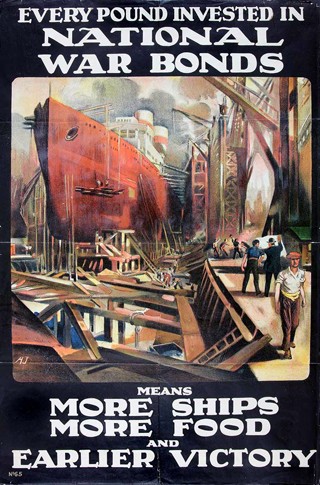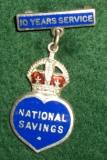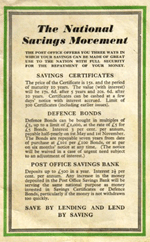Save and Prosper
 |
During the first world war (WWI 1914 to 1918) the government needed to both reduce borrowing and to raise funds for the war effort. Consequently, the National Savings Movement was established in 1916 to encourage the British people to 'save and prosper'. |
The National Savings Movement grew from volunteers who were organised into Local Savings Committees, which in turn, were supported by national committees and civil servants. Savings products were sold directly to the public and the funds were sent to the government. The range of products included, saving stamps, certificates, and bonds, which were provided not only by the Post Office Savings Bank, but by other banks and financial institutions, such as building societies. The Movement was a large scale scheme to promote saving in all its forms and the local volunteers were recognised for their dedication by the issuing of 'long service awards', which were simply named 'National Savings'.Advertisements
"Savings groups were formed in factories, shops, clubs, etc. and an appointed collector did the rounds each week to collect the savings and issue certificates."
The War Savings Campaign
To support world war II (1939-1945) the War Savings Campaign was set up by the War Office in November 1939 and Regional Savings Committees were reorganised. War savings were not only limited to the purchase of certificates and bonds, but also used local collections to raise money for aeroplanes, tanks and any items which were urgently needed for the war effort.
 |
Here's an example of a National War Bond poster... National Savings Committee poster for National War Bonds, 1918. |
Printed by HMSO for National Savings Committee
- "More Ships-Come on" "War Savings are Warships"
- Lend to Defend..... (John Pilmott): "Buy National Savings Certificates"
- Lend to Defend "Buy Defence Bonds"
- Dundee War Weapons Week "1st to 8th February" ("Tanks") "Savings Groups Double Up!"
- Aberdeen's War Weapons Week "February 8th to 15th" "Buy British Bonds & Certificates" ("Save Now or Never")
- The Silver City's Golden Opportunity. Aberdeen's War Weapons Week:."February 8th to 15th"
- "Buy British Bonds & Certificates" "Save Now or Never"
- Dundee War Weapons Week: "lst to 8th February" "Buy Buy for Victory" "Bye Bye to Hitler" ("TANKS")
- Dundee War Weapons Week: "lst to 8th February" "Save at Top Speed"
- Dundee War Weapons, Week lst to 8th February; "Convoy your Country to Victory" "Buy National Savings Certificates" (Rowland Hilder)
- "Pull Your Weight" "Form A Savings Group Now !" (Pat Keely) Dundee War Weapons Week
- "Lend to Defend the Right to be Free" "Buy Defence Bonds ... from Banks & Post Offices" "Lend to Defend His Right to be Free" "Buy Defence Bonds" (Tom Purvis)
- "Join the Crusade" "Buy National War Bonds"
- "Convoy your Country to Victory" picture of flagship (Rowland Hilder) "Buy National Savings Certificates"
- "Save for the brave!" (A Brener)
- "Save your way to Victory" "Buy National Savings Certificates"
- "Remember! Aberdeen's War Weapons Week" "Save your way to Victory"
- "Take up the challenge!" "Buy National War Bonds"
- Dundee War Weapons Week: "Savings Groups Double Up!". "Save at Top Speed!"
- "Declaration by the General Council of the Trades Union Congress"
- Warship Week Paddington 21-28.3.42 "You Can Sink Submarines by Saving Sixpences"
- Paddington 21-28.3.42 "Programme of Events"
- "War Savings are Warships" (Norman Wilkinson. P.R.I.)
- Warship Week "A Message From The Prime Minister"
- "War Savings Campaign" "A
Personal Appeal from the Minister of Labour and National
Service" Ernest Bevin - Printed for Scottish Savings
Committee
A 1951 poster, issued by the National Savings Committee, stated... "The National Savings Movement has made an immense contribution to the British way of life. For thirty-five years in peace and in war it has served the Country well."
Local volunteers were recognised for their dedication in operating the savings schemes by the issuing of 'long service awards', which were simply named 'National Savings'. Awards were issued by the National Savings Committees for periods of 1 to 45 years service.
 |
"The object was to raise money for the purchase of Defence Weapons. We would hold events such as "Spitfire Week" when all the citizens of Cardiff would endeavour to raise extra cash. Street and School Savings Groups were formed and rewards given for those raising most cash." |
Brigadier Sir John Anstey was vice chairman of the National Savings Committee in 1968 and he worked to reform the Movement at a time of high inflation when the public was keen to invest in index-linked products.
By 1969 the Post Office Savings Bank became a separate government department accountable to Treasury ministers and was renamed National Savings. From this time, local and main Post Offices became simply a distribution outlet for the products of National Savings.
In 1978 the government removed the 600 civil servants who had previously supported the volunteers of the National Savings Movement. After this time, the numbers of volunteers to run the savings schemes (as part of the National Savings Movement) diminished and a greater proportion of the general public was now saving directly with 'National Savings' (formerly the Post Office Savings Bank).
In the year 2003 the United Kingdom Parliament debated the reinstatement of the NSM as a means to encourage the public to save for their retirement with the possible introduction of a new National Savings pension bond.
With thanks to Ron Leake for suggesting 'National Savings'.
All logos and trade marks are the property of their respective owners and are used on the Light Straw site(s) for review only.Students and researchers are recommended to make their own independent enquiries as to the accuracy of the information contained therein.
